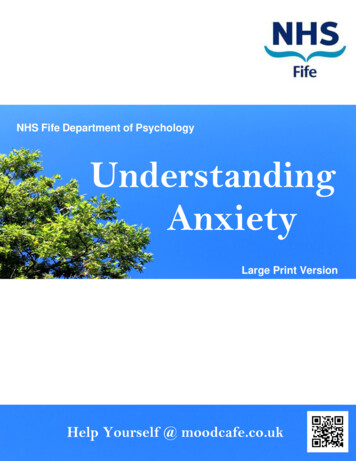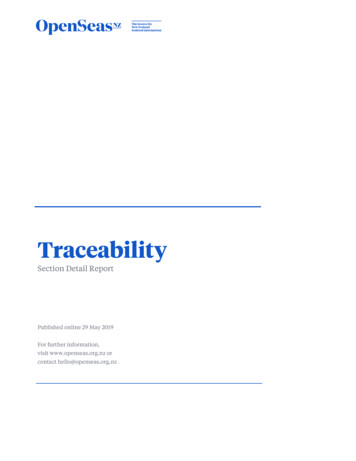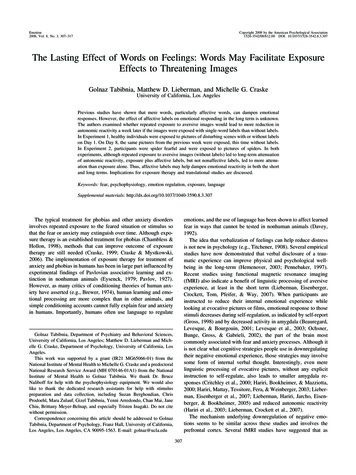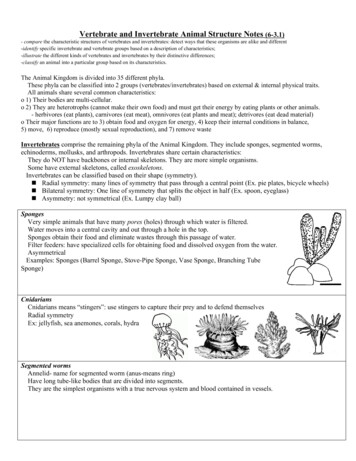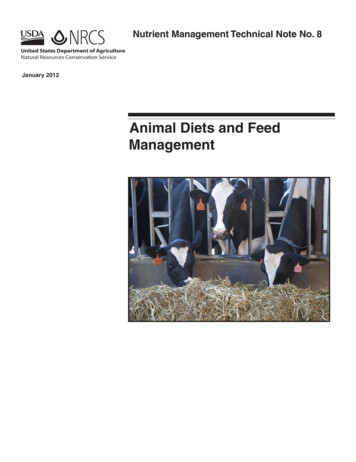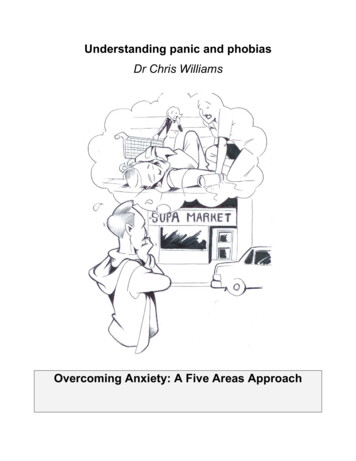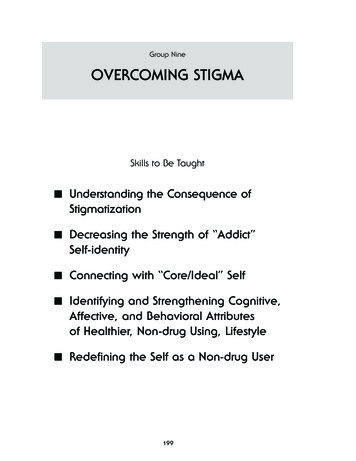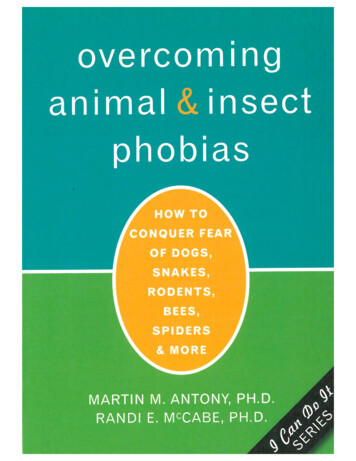
Transcription
Publisher’s NoteThis publication is designed to provide accurate and authoritative information inregard to the subject matter covered. It is sold with the understanding that the publisher is not engaged in rendering psychological, financial, legal, or other professionalservices. If expert assistance or counseling is needed, the services of a competent professional should be sought.Distributed in Canada by Raincoast BooksCopyright 2005 by Martin M. Antony and Randi E. McCabeNew Harbinger Publications, Inc.5674 Shattuck AvenueOakland, CA 94609Cover design by Amy ShoupAcquired by Catharine SutkerText design by Tracy Marie CarlsonISBN 1-57224-392-9 PaperbackAll Rights ReservedPrinted in the United States of AmericaNew Harbinger Publications’ Web site address: www.newharbinger.com0706109First printing0587654321
For Jacqui and Don Campbell—M.M.A.For Adelia and Angus—R.E.M.
Contentsacknowledgmentsviiintroduction11about animal phobias72where do animal phobias come from?243developing a hierarchy374preparing for treatment485confronting your fear656changing your thoughts967staying well117
viovercoming animal & insect phobias8helping someone else with an animalphobia129references142about the authors147
acknowledgmentsWe are grateful to Jennifer Harrington and Chris Watsonfor their comments and suggestions for improving thechapters of this book. Also, thanks to Peter Bieling,Michele Boivin, Mike Coons, Beth McConnell, ToddMurphy, Laura Summerfeldt, and Mark Watling for helping to expand upon our list of popular movies with animalscenes (chapter 4). Finally, thanks to Catharine Sutker,Carole Honeychurch, Brady Kahn, and everyone else atNew Harbinger for their support. As always, they havebeen great to work with.
introductionIf you find yourself experiencing extreme fear when facedwith certain kinds of animals, you should know that youare definitely not alone. Surveys of the general populationhave found that animals are among the most commonlyfeared situations or objects. For example, one study ofmore than eight thousand people in the United Statesfound that 22.2 percent of individuals reported an intensefear of animals (Curtis et al. 1998)—a higher percentagethan was found for any other feared situation (forexample, heights, enclosed places, storms, or blood) askedabout in the survey. Not only are animal fears commonbut a number of studies have found that people often fearmore than one type of animal (Antony and Barlow 2002),making the problem even worse. After all, animals are allaround us.
2overcoming animal & insect phobiasMost people are able to live with their fears, oftenby avoiding the animals that make them feel uncomfortable. If you are terrified of snakes but you never seesnakes or even think about them, you really don’t have aproblem. However, for some individuals, the fear of animals is a significant concern. For example, Erin had anextreme fear of cats. She was constantly scanning herenvironment for cats, and she often avoided going forwalks in her neighborhood for fear of seeing one. Occasionally, she was awoken by nightmares about cats, andshe avoided visiting friends and family members who hadthem as pets. She was even nervous watching televisionand movies, because she never knew when a cat mightappear. Clearly, Erin’s fear was a problem for her. When afear causes significant interference in your life, or when itis distressing for you to have the fear, the condition isconsidered a phobia. In one large survey (Curtis et al.1998), 5.7 percent of individuals had a fear of animalsthat was severe enough to be called a phobia.the purpose of this bookAlthough there are a number of books available on thetopic of phobias, this is the first book to focus specificallyon strategies for overcoming fears and phobias of animals.It is designed for individuals who have a fear of one ormore animals or insects; it is also designed for their families. You may be able to use the strategies described in thisbook on your own. Alternatively, the techniques described
introduction3in this book may work best for you when used under thesupervision of an experienced therapist, or perhaps with afamily member or friend who is able to work with you toovercome your phobia. Professionals who work with people who suffer from animal fears and phobias will also findthis book useful.the structure of this bookThis book is organized into eight chapters. Chapters 1 and2 provide information on the nature of animal phobias,including examples of typical animal phobias, research onthe prevalence of animal phobias, a review of effectivetreatments, and theories regarding how animal phobiasbegin. Chapters 3 and 4 focus on strategies to prepare fortreatment, including developing a hierarchy of feared situations, from most to least difficult to confront, finding thematerials you need for treatment, and considering whetherto seek professional help. Chapter 5 discusses exposure-based strategies for overcoming animal phobias. Thischapter discusses the core of the treatment—if there isone chapter you read several times, it should be chapter 5(we will return to this issue shortly). Chapter 6 discussesstrategies for changing anxious thinking about animals,and chapter 7 will help you to develop a plan to maintainyour improvements over time. Finally, chapter 8 is aimedat family members or friends who know someone with ananimal phobia and who may be involved in helping thatperson overcome his or her fear.
4overcoming animal & insect phobiashow to use this bookWe recommend that you read through the entire bookinitially, to obtain a broad overview of how the treatmentworks. As you work through chapters 1 through 4, youshould complete the recommended exercises, which willprepare you for using the treatment strategies described inchapters 5 and 6. Once you have finished reading theentire book, return to chapters 5 and 6. We recommendthat you read these chapters a second time and that yourepeat the exercises (especially the exposure exercises inchapter 5) until your fear has decreased. Chapter 7 shouldbe read again, after your fear has decreased and you areready to consider strategies for staying well. Although theentire book may be of interest to family members or otherswho are helping someone work through his or her phobia,chapter 8 will be particularly useful for this purpose.We recommend that you use a journal or notebookto complete the exercises throughout this book. In fact,don’t bother reading any further until you have obtainedyour journal. Without practicing the various strategiesdescribed in the book, it is unlikely that you will notice asignificant change in your fear. Keeping a journal willmake it easier to keep up with the exercises.can a self-help book really help?Of all the different types of specific phobias that peoplehave, animal phobias are the most thoroughly researched.
introduction5Procedures for overcoming animal phobias are well developed, and there is considerable evidence that severe fearsof animals can be overcome fairly quickly for most individuals. In fact, in some studies, up to 90 percent of peoplewith an animal phobia were able to overcome their fears ina single session lasting, on average, less than three hours(Öst 1989). Not only that, but most studies find thatpeople who overcome their animal phobias are usuallyable to maintain their improvements over the long term(Öst 1996).However, most of the research on treating animalphobias is based on treatment with a trained therapist.Only a small number of studies have investigated the useof self-help treatments for animal phobias, and all of thesehave been based on spider phobias. The few studies thathave been conducted have had mixed results, but overall,treatment with a therapist tends to be more effective.Nevertheless, between 30 and 60 percent of people canachieve significant improvement with just a thirty-pageself-help manual (Hellström and Öst 1995; Öst,Salkovskis, and Hellström 1991; Öst, Stridh, and Wolf1998). Some people clearly can overcome their fears ontheir own.Based on research by psychologist Lars-Göran Östand his colleagues (Öst, Stridh, and Wolf 1998), the bestpredictors of whether you will benefit from self-help treatment for animal phobias include how motivated you areto improve and the extent to which the treatment makessense to you (in other words, how credible or believablethe manual seems). Here are a few variables that were
6overcoming animal & insect phobiasfound to play little or no role in predicting whetherself-help treatment will succeed: the age at which yourfear began, the number of years this fear has been present, whether there is a history of phobias in your family,and the severity of your phobia. So it doesn’t matter howlong you have had your fear or how severe it is. If you aremotivated to conquer your fear and you follow thedetailed suggestions outlined in this book, you have agood chance of overcoming your fear.Although treatment is usually effective and brief, itis rarely easy. Treatment will require you to confront theanimal you fear in a controlled, gradual way. In all likelihood, exposure to your feared animal will lead you to feelvery uncomfortable and frightened. Initially, you mayexperience panicky feelings, crying, nightmares, and otherunpleasant reactions. A decision to overcome your animal phobia must include a willingness to feel uncomfortable at the beginning of treatment for the purpose ofeventually reaching a point where you can be around theanimal with little or even no fear. Although the treatment is uncomfortable, this is something you can do.Even if a self-help approach is not for you, this bookmay still be helpful. Understanding the nature of yourfear and learning about the strategies that have proven tobe useful for overcoming a fear of animals will help prepare you to eventually confront the problem. At the veryleast, the treatment strategies described in this book areeffective for almost everyone, when used with a therapist.If you want to overcome your fear, there is no reason whyyou can’t do it.
1about animal phobiasAnimal fears are the most frequently reported fears inthe general population. Though the most commonlyfeared animals include creepy, crawly creatures, such assnakes, spiders, rodents, and bugs, other animals that areoften feared include dogs, cats, birds, and bees. In fact,people can have a fear of just about any animal. For example, we have seen people with specific fears of worms,moths, squirrels, fish, cockroaches, ants, sharks, and owls.Many animal phobias have “official” names based on theirLatin and Greek roots, though in practice these names arerarely used by people, including even researchers andprofessionals who work with people who have phobias. Inother words, a phobia of spiders is usually just called a“spider phobia,” rather than by its medical name,arachnophobia. Still, for the sake of interest, below is a list
8overcoming animal & insect phobiasof twenty-five documented animal phobias and their medical names.proper medical names for variousanimal phobiasThe following list of animal phobias comes fromwww.phobialist.com:amphibians (for example, frogs, obiaants—myrmecophobiabees—apiphobia or bia, elurophobia, galeophobia, orgatophobiachickens—alektorophobiadogs (or nidaphobiahorses—equinophobia or hippophobiainsects—entomophobia or insectophobiamice—musophobia or muriphobia
about animal tiles (or creepy, crawly fish—ostraconophobiasnakes—ophidiophobia or snakephobiaspiders—arachnephobia or nophobiawasps—spheksophobiawild animals—agrizoophobiaworms—scoleciphobiawhat is an animal phobia?Nearly one in four people reports a fear of at least one animal. In fact, it is perfectly normal to be uncomfortablearound dogs, snakes, bees, or other animals. Most of thetime, having such a fear doesn’t really get in the way oflife, and it doesn’t cause much distress or concern.Encounters with a feared animal may be infrequent, thelevel of fear may be mild, the fear may not impact upon aperson’s day-to-day life, and treatment is unnecessary.
10overcoming animal & insect phobiasSuch cases would not be referred to as animal phobias.Rather, we would describe these as fears of animals.The term animal phobia refers to a specific type ofanxiety disorder known as a specific phobia (AmericanPsychiatric Association 2000). A specific phobia is anexcessive or unrealistic fear of a specific object or situation, such as an animal or insect, heights, driving, flying,storms, enclosed places, the sight of blood, or getting aninjection. The terms excessive and unrealistic mean thatthe fear is extreme and out of proportion to the actualrisk in the situation (though there may really be a smallrisk of danger). In addition, the term phobia implies thatthe fear is severe enough to cause considerable impairment in a person’s life (it must interfere with work, homelife, relationships, hobbies, or other areas of functioning),or significant distress (in other words, it deeply bothersthe person that he or she has the fear). We will return tothe issue of impairment later in this chapter.features of animal phobiasAnimal phobias typically involve an experience of panicand fear upon confronting the feared animal, avoidance ofthe feared animal, anxious thinking patterns, and a feelingof disgust.
about animal phobias11panic and fearWhen people with phobias encounter a feared animal, their bodies react almost immediately to deal withthe perceived danger. The reaction is often called a fightor-flight reaction because the response is typically one ofaggression (for example, immediately killing a spider) or,more typically, one of escape (running away from a bee).Many of the symptoms experienced during fear are physical, and the fear response is often referred to as a panicattack. A panic attack is simply an experience of fear thatcomes on quickly and is accompanied by at least four ofthe following symptoms: (1) racing or pounding heart, (2)sweating, (3) trembling or shaking, (4) shortness ofbreath, (5) feelings of choking, (6) chest pain or tightness, (7) nausea, (8) dizziness or lightheadedness, (9)feeling unreal or detached, (10) numbness or tinglingsensations, (11) chills or hot flushes, (12) fear of dying,and (13) fear of going crazy or losing control. Most peoplewith animal phobias experience panic attacks when theyencounter their feared animals.avoidance of the feared animalIn addition to the experience of panic, one of themost important features of animal phobias is the tendencyto avoid the feared animal. In fact, the urge to escapefrom the feared animal can be overwhelming. People withanimal phobias will often do whatever they can to avoidthe feared animal, sometimes even putting themselves at
12overcoming animal & insect phobiasrisk. For example, we once worked with a woman whowas fearful of spiders. One day she was backing out of herdriveway when she saw a spider in her car. She was soterrified that she quickly opened the car door and exitedthe car—while it was still moving. Fortunately, a friendsitting in the passenger seat was able to stop the car andprevent an accident.Other examples of avoidance include the following:7Crossing the street after seeing a dogapproaching on a leash7Avoiding parks for fear of seeing a bird7Avoiding swimming in lakes or oceans forfear of encountering fish7Avoiding vacations in tropical climates forfear of seeing a large spider7Avoiding watching nature shows on television for fear of seeing a snake7Turning down an invitation to a picnic toavoid seeing bugsSometimes patterns of avoidance can be moreextreme. For example, we have seen individuals who cannot even say the word “spider” or “snake.” One person weworked with would not take baths because of her fear offish. She knew that she was unlikely to see a fish in herown bathtub, but being in the tub still made her fearfulbecause it reminded her of situations (like swimming in a
about animal phobias13lake) where she might see fish. Another individual wouldnot even walk on the floor in her own living room for fearof encountering spiders. At bedtime, she would make herway from the living room sofa to the stairs by jumpingfrom one piece of furniture to the next, with her feetnever touching the floor.Avoidance may also be more subtle. For example,people often do small things to protect themselves fromfeared animals. They may rely on safety cues—items theycarry with them in order to feel safe. One person weknow who is fearful of dogs always carries a box of dogbiscuits with him when walking around his neighborhood.Upon seeing a dog, he throws a dog biscuit in one direction while he runs off in the other direction hoping thatthe dog will chase after the biscuit. In this example, thedog biscuits are a safety cue because they make him feelmore comfortable while walking around. Of course, thevery smart dogs—perhaps the ones who can read thepackage—see that he has a whole box of biscuits andthey run after him instead of the biscuit he threw!Other examples of subtle avoidance behaviors, overprotective behaviors, and reliance on safety cues includethe following:7Wearing long pants so spiders don’t crawlon your legs7Closing your eyes at a movie during a sceneinvolving snakes
14overcoming animal & insect phobias7Carrying pepper spray in case of encountering a dog7Having a family member scope out theneighborhood before you leave the house,to make sure there are no cats around7Carrying bug spray with you at all timesAvoidance, whether obvious or subtle, can lead to anumber of problems. First, it is the avoidance that oftenleads to the most interference in your life. Second, byavoiding a feared animal, you never get to learn that thesituation is actually safe. Learning to confront situations,rather than avoid them, is a key component of overcoming any phobia.anxious thinkingPeople who fear animals often have anxious beliefsabout their feared animals that are either untrue or exaggerated. For example, if you fear birds, you may assumethat birds can tell when you are anxious and that allowing your anxiety to show increases the chances of a birdflying toward you. In fear, there is also a tendency foryour attention to focus more narrowly on the source ofthe threat. For example, if you fear spiders, you may automatically scan each room you enter for signs of spiders. Ifthere is a spider in the room, you may be the first personto find it. In fact, if there is a black dot on the wall, you
about animal phobias15may be the first person to find that (or anything else thatreminds you of a spider) as well.People who are fearful of animals also tend to perceive and remember information in a way that supportstheir fearful beliefs. They may remember a dog they sawpreviously as being larger than it really was. They mayalso ignore information that is inconsistent with theiranxious beliefs (they may ignore all the dogs theyencounter that are unaggressive). Fear is also associatedwith a tendency to interpret certain events as dangerouswhen, in fact, they are not. For example, someone who isfearful of snakes may misconstrue a snake’s normal movements as a sign it is going to attack.Not surprisingly, if you believe an animal is dangerous and if you only pay attention to and rememberaspects of the situation that confirm your fear, you willcontinue to be afraid of the animal. An important step inovercoming an animal phobia is learning to think aboutthe animal in a more balanced and realistic way. Exposingyourself to the animal you fear is one strategy for changing the way you think. Learning more about your fearedanimal, and directly examining whether the evidencesupports your anxious beliefs, may also be helpful.the role of disgustFear is not the only emotion that people with animal phobias report during encounters with a feared animal. A number of researchers have shown that a commonexperience shared by many people who fear spiders,
16overcoming animal & insect phobiassnakes, rats, and certain other animals is a feeling of disgust (Woody and Teachman 2000). In other words, inaddition to experiencing a sense of danger or threat inthe situation, people may experience a sense of revulsionor being “grossed out.” In fact, many of the challengesconfronted by contestants on the television show FearFactor are actually designed to trigger disgust. One contestant described the experience of having to eat wormsduring an appearance on the show in this way: “It wasdisgusting. I threw up. It was horrible.” The emotions offear and disgust may go hand in hand in some situations.If your reaction to a feared animal tends to be oneof disgust, there are a couple of things you should keep inmind as you work though this book. First, the treatmentsdescribed in this book are effective, regardless of whethera person experiences high levels of disgust during exposure to the animal they fear (Merckelbach et al. 1993).Second, researchers have shown that treatment leads todecreases in disgust reactions in addition to decreases infear (de Jong, Andrea, and Muris 1997).who develops animal phobias?Almost 6 percent of individuals suffer from a fear of animals that is severe enough to cause significant interferencein their lives (Curtis et al. 1998). The prevalence of phobias regarding creepy, crawly animals (spiders, snakes,mice, and bugs) is considerably higher (6.63 percent ofwomen and 2.44 percent of men) than that for other types
about animal phobias17of animals, such as dogs, cats, and birds (1.42 percent ofwomen and 0.33 percent of men) (Bourdon et al. 1988).You may notice from these statistics that 70 to 80percent of people with animal phobias are women. Whywould animal phobias be more common in women thanin men? There are a number of possible explanations.First, one of the triggers for fear is watching other peoplebehave fearfully. In Western cultures, women may havemore role models for learning to fear animals than domen. For example, in movies and on television, it is muchmore common to see a female character showing fear ofan animal (and perhaps a male character protecting herfrom the animal) than the other way around. Even in cartoons, it is common to see a woman (but never a man)standing on a chair screaming in terror when a mouse isin the room. Children learn to fear situations in part bywatching others who are similar to them act fearfully.Other cultural factors may also play a role. In manysocieties, it is more acceptable for women to express fearthan it is for men to express fear. Men may therefore bemore likely to confront feared situations rather than allowthemselves to avoid situations and risk being ridiculed orsuffer other negative consequences. In fact, there is evenevidence that in comparison to women, men are morelikely to downplay or underestimate their fears (Pierceand Kirkpatrick 1992). Finally, it is possible that there arebiological differences between men and women that makewomen more vulnerable to developing animal phobias.On average, animal phobias tend to begin at an earlier age, relative to other types of phobias. In fact, many
18overcoming animal & insect phobiaspeople report having had their animal phobia for as longas they can recall. Whereas some studies have found anaverage age of onset for animal phobias in early childhood(for example, ages four or five), several other studies havefound an average age of onset in the mid-teens (Antonyand Barlow 2002). One reason for the different findingsacross studies is that many researchers fail to take intoaccount the distinction between the onset of the fearitself, versus the onset of the full blown phobia. The average person experiences a fear of animals for several yearsbefore it reaches a level at which it causes interference inthe person’s life (Antony, Brown, and Barlow 1997).the impact of phobiasRemember, a fear of animals becomes a true animal phobia when the fear is so strong that it impairs your functioning. People often trivialize phobias. They may think, “Whocares if you are afraid of dogs? Just don’t get a dog.”Though some animal fears can be trivial, true animalphobias are not. They can seriously interfere with yourday-to-day life. Fortunately, they also respond very well totreatment. Below are some examples of how particularanimal phobias can get in the way, either for an individualor for his or her family:7Jacob’s family had been planning a trip tothe Grand Canyon for almost a year. Theyhad to cancel the trip at the last minute
about animal phobiaswhen Jacob read about the large spidersthat live in Arizona.7Amy was a thirty-five-year-old lawyer whomoved from her own house into her parents’ home after seeing two cockroaches inher living room. Even though her househad been fumigated and there were nosigns of cockroaches anymore, she couldnot return to her home even two monthsafter seeing the cockroaches.7Janet refuses to visit her in-laws becausethey own a dog. Even if they lock the dogin one of the bedrooms, she still doesn’tfeel safe.7Zachary is a teacher who left work for theday after one of his second grade studentsbrought in a small snake for “show andtell.”7Parmjit will not leave her home if she sees asquirrel outside her window. On occasion,she is late for work, from waiting up to anhour for a squirrel to leave.7During the summer months, Lauren cannotgo anywhere where she might encounterbirds. She avoids the beach, eating in outdoor cafés, walking in her neighborhood,and visiting parks. It affects what she and19
20overcoming animal & insect phobiasher family do on the weekends, and it evenaffects her job as a real estate agent. Duringthe summer months, she typically has herclients explore the outdoor areas of housesthat they are considering while she waitsinside.7On a typical night, it takes Roberta morethan two hours to fall asleep. Before gettinginto bed, she checks throughout her roomfor spiders. She keeps the light on all night,so she can see a spider if one appears. Shesleeps fully clothed to keep spiders off herbody, and she often wakes up in the middleof night from a nightmare involvingspiders.overcoming animal phobiasThough animal phobias are among the most common phobias, they are also among the most treatable. In fact, manypeople with animal phobias can overcome their fears injust a few hours or days. There are numerous welldesigned studies documenting effective treatments forphobias of snakes, spiders, and rats (Antony and Swinson2000). There are also smaller studies and case reports ontreating other types of animal phobias (including fear ofbirds, sharks, mice, dogs, cats, and others), suggesting thatsimilar treatments work for a wide range of animal fears.
about animal phobias21An essential component of effective treatment forany animal phobia is prolonged exposure to the animal.But don’t worry—we don’t expect you to spend hourswith the animal you fear right away. The exposure occursgradually. For example, you may start with looking at theanimal from far away, looking at pictures of the animal,or even just saying the name of the animal. Even theselimited forms of exposure will begin to erode your fear. Asyour fear decreases, you will be encouraged to move tothe next steps, which involve increasing the intensity ofthe exposure. For example, this might involve moving abit closer to the animal. Eventually, you will reach a pointat which you can be close to the animal and even touchit with little fear (assuming it is not dangerous, like a venomous snake).To be effective, exposure needs to be predictable. Inother words, you should know what is going to happenand when it will happen. You should also know that youcan terminate the exposure at any point if the need arises(although it is always best not to escape from the situation early). You will further increase the likelihood ofsuccess if you schedule your exposure practices closetogether, make sure that you stay in the situation untilyour fear comes down, and try to practice in a number ofdifferent locations and situations. You will learn to stopusing subtle avoidance strategies such as distraction,overprotective behaviors, and safety cues. Such behaviorsare thought to maintain your fear over time and mayinterfere with the benefits of exposure.
22overcoming animal & insect phobiasAs you can imagine, exposure may be somethingthat you cannot do on your own. For example, if you fearmice, you will probably not be able to buy a mouse at apet store to use for your exposure practices. Finding ahelper (a family member or friend who can practice exposures with you) may be essential. In some cases, treatment with a trained therapist may be the best option.This issue is discussed in more detail in chapter 4.Learning to think differently about the animal mayalso be useful. Chapter 6 discusses detailed strategies foridentifying your anxious beliefs and predictions, examining whether they are accurate, and learning to replaceanxious thoughts with more realistic beliefs. These strategies are meant to be used in addition to exposure (not asa substitute for exposure).A key to maintaining your gains after you haveovercome your fear is to continue occasional exposures tothe animal and to deal with any return of fear as it arises,before it gets out of hand. Chapter 7 discusses strategiesfor maintaining your improvement over the long term.We recommend that any family members who areaffected by your fear, as well as any individuals who willbe helping you to overcome your fear, read this book,paying extra attention to the information in chapter 8.
about animal phobias23SummaryThis chapter offered an overview o
fear causes significant interference in your life, or when it is distressing for you to have the fear, the condition is considered a phobia. In one large survey (Curtis et al. 1998), 5.7 percent of individuals had a fear of animals that was severe enough to be called a phobia. the purpose of this book
